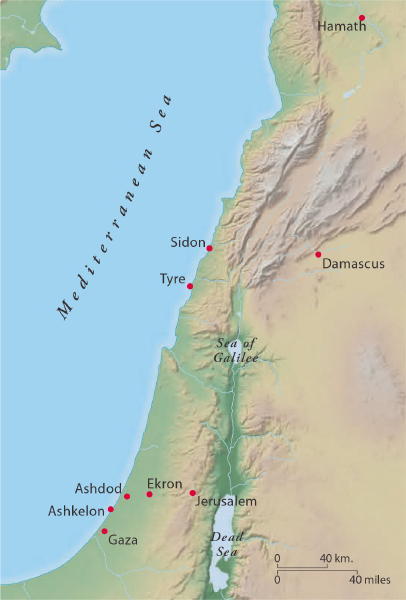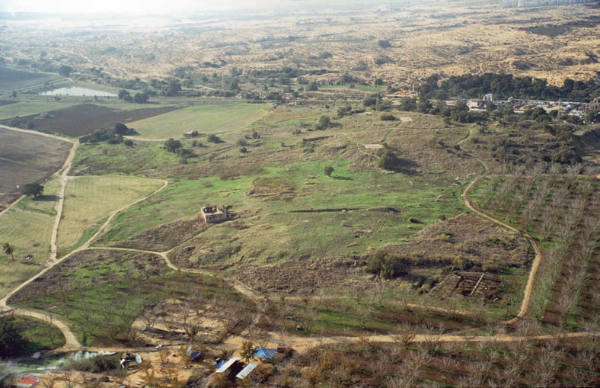Zechariah’s Eighth Vision (6:1–8)
Mountains of bronze (6:1). It is not entirely clear what the prophet is trying to convey with this image. Some believe it refers to a common Mesopotamian image of the sun god rising between two mountains, the morning light making rock appear bronze in color. Others see in the reference to bronze as an allusion to fortifications, bronze being used for gateways and other defensive works. Mountains were often seen as the home of God.
A Crown for Joshua (6:9–15)
The Branch, and he will branch out from his place and build the temple of the Lord (6:12). It is not clear to whom the prophet is referring, and the term used here for “branch” is not the same term used in Isaiah 11:1 to refer to a coming ruler. Scholars tend to argue two ways on the identity of this figure: given the earlier promise that Zerubbabel will be the one to complete the temple (4:9), the branch is Zerubbabel, and hence the prophet anticipates a coronation of the governor as a king over an independent Judah. The other approach is to see this as a future ruler, a messianic figure, who will benefit from the faithfulness of Joshua and the temple priesthood. There is no indication that Jerusalem at this time period could have envisioned a successful revolt against the Persian empire since the city was unwalled and impoverished.48
In the broader ancient Near Eastern context the term “branch,” or terms based on similar metaphors, have been attested as technical terminology referring to the rightful heir for an established dynastic line. In a Phoenician votive inscription to Melqart found in Lapethos (Lambousa) on Cyprus “branch” is used of a ruler from the Ptolemaic line in Egypt.49 In Mesopotamia similar metaphors appear across a range of time. In a hymn to Lipit-Ishtar the king is referred to as “shoot of royalty.”50 Note also the description of a king as “everlasting seed, offspring (=pirʾu) of Enmeduranki, King of Sippar.”51 In closer time context, from the time of Tiglath-Pileser III on, the title pirʾi occurs in Neo-Assyrian inscriptions.52
Hen (6:14). While many English translations render this as a personal name, there is good evidence to see this as a title for a temple steward, so the crown is being entrusted to several individuals, including “Josiah the steward, son of Zephaniah”53 (the identification of “Josiah” coming from his identification as the “son of Zephaniah” in v. 10).
Justice and Mercy, Not Fasting (7:1–14)
Fourth day of the ninth month, the month of Kislev (7:1). This would be around December of 518 B.C., about two years since Zechariah’s opening oracle.
Fast in the fifth month (7:3). Fasts typically marked major national disasters, of which there had been many in the recent history of Israel. Since the text provides no explanation of what these fasts marked, we can only offer suggestions based on matching up events with months. We know that Nebuchadnezzar’s destruction of the temple took place in the fifth month (2 Kings 25:8), and since it is the temple that is being rebuilt, it makes sense that the delegation has come to inquire about whether the fast should be continued.
Fasted and mourned in the … seventh month (7:5). It is much more difficult to identify a historical event that would have occasioned a fast in the seventh month. Of the events that occurred surrounding the destruction of the temple and Jerusalem, the only one that is stated to have taken place in the seventh month is the assassination of Gedaliah (Jer. 41), the governor appointed by Nebuchadnezzar after the right to kingship had been revoked.
The Lord Promises to Bless Jerusalem (8:1–23)
All these things as an inheritance (8:12). As noted in the comments on Haggai 2:19, it was common in the ancient Near East to connect the establishment of a temple with the coming of blessing in the form of prosperity. The prophet is expressing the same theme, that prosperity is surely coming since the community is completing the rebuilding of the temple.
By the hem of his robe (8:23). In the ancient Near East, grasping the hem of the robe presumes the petitioner is on his knees, so this is an action of throwing one’s self completely on the mercy of the person receiving the petition.54 A classic example of this motif is found in a hymn of King Ashurbanipal (referring to himself): “May he who kneels by the hem of Ishtar of Uruk not come to shame in the assembly of his detractors.”55 Here the petitioner asks that his honor be maintained in spite of his physical gesture of complete humility.
Judgment on Israel’s Enemies (9:1–8)
Hadrach … Damascus (9:1). Damascus was an important administrative center in the Persian empire and may have been the administrative center of the Persian satrapy of which Jerusalem was part.56 Hadrach is well known from Assyrian sources as Hatarikka (the city over which Zakkur was king), even though it is otherwise absent from the biblical record. The city’s location is uncertain, despite frequent reference to it in the literary sources. Parpola and Porter locate it about fifteen miles further along the road that runs northeast from Damascus.57 Recent excavations at the site of Tell-Afis (45 kilometers southwest of Aleppo), however, suggest that this is the location of Hadrach.58

Cities of Zechariah 9
Both of these cities are in the Persian satrapy of Abarnahara (“Across the River”), which was bordered on the east by the Syrian desert and stretched from eastern Sinai and the Gulf of Aqaba up through Syria to the west bank of the Euphrates, thus roughly covering the area of the empire of David and Solomon from earlier times. It is possible that these are provinces, but too little is known of the provincial names of this period to be certain.
Hamath (9:2). The city of Hamath, located about 130 miles north of Damascus on the shore of the Orontes, may also be a provincial designation. The modern city has limited the areas that may be excavated and little has been recovered from this period.59
Tyre has built herself a stronghold (9:3). Tyre was a growing economic center under the Persian empire and the focus of a major campaign by Alexander the Great, who took the city in 332 B.C. It was frequently the rival of Sidon, until Sidon was destroyed in 351 B.C.60
Gaza will lose her king (9:5). During the Persian empire it appears that Gaza and the regions around it were under a “dimorphic” administration, a provincial governor representing Persian interests and a native king maintaining traditional powers. So Gaza’s loss of its king anticipates its coming more under the direct control of the empire.61
Ashdod (9:6). The seventy-acre site of Ashdod is located near the coast north of Ashkelon. It had the advantage of location on the main coastal highway and of being close enough to the sea to have a small harbor. The city was destroyed by Nebuchadnezzar, but was rebuilt in the Persian period. Excavations have uncovered this settlement, though later Hellenistic building activity obliterated major sections of the Persian town.62

Ashdod
Todd Bolen/www.BiblePlaces.com
Ekron … like the Jebusites (9:7). The site of Ekron (Tel Miqne in the Sorek Valley) is located about twenty-two miles southwest of Jerusalem and about fifteen miles from the Mediterranean. The site has been extensively excavated and consists of a lower city of about forty acres, an upper tell of about ten acres, and an acropolis. Its main industry was the production of olive oil.
The archaeological excavations attest to the massive destruction of the town by Nebuchadnezzar in the last years of the seventh century B.C. Literarily, this is attested in the Aramaic Saqqara papyrus (the “Adon” letter) in a letter from the king of Ekron to the Egyptian pharaoh requesting support.63 No archaeological evidence suggests it was resettled in the Persian period.64 This raises the unanswerable question of why this town should be mentioned in a text a century or more after its destruction. Finally, in this judgment oracle the comparison of Ekron to the Jebusites most likely indicates its absorption into the population of Judah.65